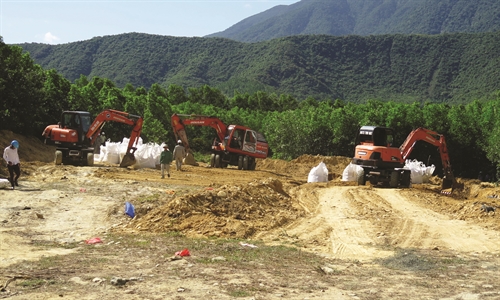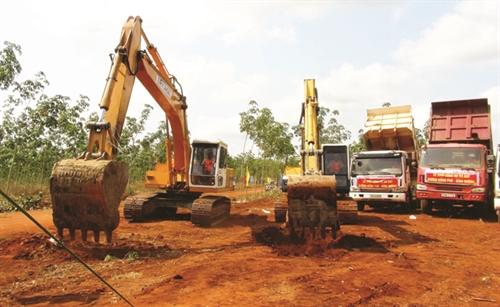There is growing consensus within the anti-corruption field that the most effective anti-corruption programs target interventions at a sectoral level. Reforms at this level are more likely to attract political and local stakeholder support than more broadly targeted anti-corruption programs. Much analysis of anti-corruption reforms emphasizes the importance of improving transparency, public participation and accountability. What is often absent from this analysis is an acknowledgment that corruption is socially constructed; state and non-state actors frequently have different understandings about what constitutes corrupt behavior.
 |
| A discussion on curbing corruption in land administration held in Hanoi by the National Economics University and UNDP Vietnam__Photo: http://noichinh.vn |
In 2016, the National Economics University (NEU) and the United Nations Development Programme (UNDP) in Vietnam conducted the sectoral study of transparency and corruption in land acquisition in Vietnam. The research paper coming from the study was launched in December 2016.[2] This study aimed to shed light on corruption in land development government-private partnerships (GPPs) - a rapidly growing type of land investment. By analyzing corruption in land development using the social construction approach, we aimed to generate new insights into the causes of corruption in land development projects, and to propose fresh sets of policy-relevant insights that will lead to new anti-corruption measures. In particular, we studied to identify corruption types in land development GPPs through case studies on infrastructure development and mining projects that involve state-led land clearance and non-state investments, looked into different corruption drivers in the GPP projects and recommended relevant anti-corruption measures from the perspective of social construction, which assess corruption based on violation of public interests rather than simply on the violation of regulations.
During the research process, we started with examining two governance measures, the Vietnam Provincial Governance and Public Administration Performance Index (PAPI)[3] and the Provincial Competitiveness Index (PCI)[4], which provide data and information about corruption risks from the perspectives of citizens and businesses. We then conducted in-depth interviews with citizens and business owners based on five case studies that involved different types of land development GPPs, including new residential development projects, a new commercial market, gravel-pit mining and land consolidation in rural development. The cases, as presented in Table 2, are real but to protect their confidentiality, we coded their names.
We approached the study with two dimensions of corruption:
- Policy discretion: In standard economic theory, corruption is considered as driven by the power of discretion. When self-seeking officials are able to take discretionary action, they are likely to be corrupt, using such action to benefit specific interests including their own.
- Coalition between officials and businesses: Corruption arises when public officials and non-state partners collude for the sake of their own private interests. The collusion nullifies current policies as the coalitions make their own policies for the benefits of so-called ‘interest groups’. Such behaviors are particularly apparent when the distinction between state and non-state functions are blurred and the relationship between state and non-state is commercialized, as in GPP projects.
Based on these two dimensions, we broadly classified corruption observed in the five case studies into four types.
 |
When collaboration is low, corruption comes in two types: “village norms” and “black market”. “Village norms” corruption arises when discretion is low, and firms are forced or volunteer to pay informal charges. This type of corruption mostly involves bribery, which is used to pass administrative procedures, following informal norms created by different actors. “Black market” corruption happens when public officials have large power of discretion they can use for private gains. In this situation, public officials and non-state actors can bargain to divide social benefits.
When collaboration is high, there are two types of corruption: “bid collusion” and “policy corruption”. In cases where policies are clear and specific, public officials have low discretion. They could collude with their partners to nullify the policies, i.e., by implementing the policy artificially, by delaying the implementation, etc. This is quite evident in tendering activities and also in other areas where public officials and their partners collude to implicitly decide the results. This type of corruption is called “bid collusion”. When discretion power is high, public officials might collude with their partners to develop policies for their private gains. This type of corruption is “policy corruption”.
The four types of corruption were analyzed in respect to the five case studies. Table 2 presents the five cases and the typology of corruption that may embed in each of the cases. This categorization of the four types can be used to identify coalition-based corruptions in GPPs and demonstrate the complexity of corruption in these projects.
Table 2: An analysis of corruption behaviors from five land-related case studies
| Mountain Town | Greenpark | Market Renovation | Quarrying | Hoa Van New Rural Development | |
|---|---|---|---|---|---|
| About the case studies | This case is generally representative of new residential developments in the Northern mountainous area of Vietnam. The new residential project in this study is located in a mountainous province in the north where there are about 20 other residential projects under development. | This case study took place in a province in the Red River Delta of Vietnam. The province is located near the capital city but it has a lower GDP per capita. Moreover, the province is usually ranked amongst poor PCI and PAPI performers. The investment environment thus can be deemed to be less favorable to businesses and unhealthy for development. | This case is about a traditional market being converted into a modern supermarket. The traditional market is located at the center of a provincial city with high population density. Located nearby is a train station that receives dozens of cargo and passenger trains daily. Nearby is a busy international border gate, and several significant tourism sites. | This case study investigates corruption risks in mineral exploitation in a northern mountainous province with great potential for mining and mineral processing. This province has low PAPI and PCI scores, and it is so poor that its state budget revenue was a mere VND 850 billion, accounting for 11 percent of its total state budget expenditure in 2015. | Hoa Van is a peri-urban commune of Hanoi which has about 1,700 households comprised of 6,500 people. The commune relies largely on agricultural production. Hoa Van commune leaders (particularly the former chief of the commune CPV cell) conceptualized the idea of land consolidation in 1992, long before the national New Rural Development (NRD) Program was initiated. |
| Types of corruption | All four types of corruption were present, notably in land planning and allocation (bid collusion) and project implementation (policy corruption) | “Bid collusion” and “Policy corruption” were most evidenced in the case | All four types of corruption were present, notably in land planning and allocation (bid collusion) and project design (policy corruption) | All four types of corruption were present, notably in procedure (village norm), environment impact assessment (bid collusion) and quarrying right fees (market) | No corruption was found, either from legal or social perspectives |
| Private benefits |
Developer’s revenue from sales Individual officials’ informal incomes (bribes) and sharing benefits |
Developer’s land use rights to 500 hectares of residential park Potential for a large profit |
Developer: revenue from sales and from owning the market for 70 years “Underground” forces involved Lack of information about public officials’ gain |
Developer: extractive resources for sales Some public officials’ “backyard” firms were contracted Environment impact assessment Officials gain from bribes in allowing procedures to go ahead |
No corruption was found by the provincial inspection team and project could go ahead |
| Public goods or harms |
A modern residential area and community affected inc. livelihood and traditional living |
A modern, internationally recognized residential park built Community livelihood affected (local farmers lost productive lands) |
A modern market built with potential for greater profits Uncertainty about the livelihood of small businesses owners |
Fees for mining rights and taxes Environmental damage |
New rural infrastructure developed Land consolidated for development Community’s living standard improved Some regulations violated |
| Types of collusion |
Collusion between developer and provincial officials in planning, compensation, resettlement, construction, etc. |
Developer strongly supported by central and provincial governments |
Collusion between developer and provincial officials |
Approved mines: between provincial and developers Un-approved mines: between district and commune with developers (by intentional ignorance for the developer to extract small mines) |
Commune officials and the community “colluded” to work on a new rural development initiative |
| Community involvement | Not much: community only informed about plan and policies |
Were informed about plans and policies Were “persuaded” to comply Felt that they were “being forced” to comply |
Not much: community were informed about the plan and policies only | Were not informed, since the mining was supposed not to directly affect people’s lives | Involved as “owners” of the program |
| Informal forces/ violence | - Not yet visible |
- Citizens claimed that informal forces threatened them - Government blamed “anti-government forces” for seducing people |
- “Underground forces” informally managed some part of the market operation, e.g., guards, transportation workers [according to traders]. - “underground forces” involved in the project process [according to developer] |
Not evidenced | None |
Deeper analysis, as presented in NEU and UNDP (2017) shows that corruption from the GPP projects is prevalent and complex. Meanwhile, current anti-corruption agendas have not effectively addressed this type of ‘collusion-based’ corruption. Our study showed that public participation is a key way of disrupting collusion-based corruption; however, anti-corruption programs do not effectively promote citizen and business involvement in decision-making processes concerning the projects under study.
Our recommendations therefore focus on three groups of measures to better control corruption in GPP projects. They include: (i) addressing collusion-based corruption; (ii) promoting genuine citizen participation through deliberative policymaking design; and (iii) developing a responsible, innovative and integrated private sector.
Addressing ‘collusion-based’ corruption
Over the last decade, the government has strengthened the legal framework to prevent corruption, especially in PPP or GPP projects. Firstly, an increased number of strict regulations have been issued or revised, including the Anti-Corruption Law, the Law on Public Officials, the Law on Public Employees, the Land Law (2013), the Public Investment Law (2014), and the Mineral Law (2010), etc. Secondly, the implementation of public administration reforms (PAR) that streamline procedures continue to be a government priority. Finally, capacity building for government officials has been seen as key to successful reform. Together, these de jure measures are aimed at minimizing “policy discretion”, a key driver of corruption.
Despite regulatory reforms, corruption remains prevalent and serious. Studies show different types of corruption, and a possible shift from discretion-based (village norms and free market) to collusion-based (policy corruption and bid-collusion) corruption. Collusion-based corruption is often socially damaging because it bends state laws for private benefit, and in doing so erodes public trust in state land management.
Our findings suggest that reforms should tackle collusion-based corruption more vigorously. First, official-business connections that create conflicts of interest need to be strictly regulated. Examples include officials who stand behind businesses (or “backyard businesses”), officials with family members who own businesses that operate in areas they supervise, officials who participate in employment outside the public arena, etc. The revision of the Anti-Corruption Law needs to address conflicts of interest arising from official-business connections. It is crucial to broaden the scope of application of conflicts of interest regulations to cover not only public servants but also other actors with close relationships with public servants, including their spouses, children, siblings, and other relatives. In addition, a database on public servants’ incomes and assets should be developed and used to monitor changes in income and wealth. An assets database will help detect and prevent conflict of interests. (See World Bank, 2016) for a more comprehensive discussion of conflicts of interest.
New policies should be reviewed for potential “collusion”. According to the Law on Laws (2015), the Ministry of Justice reviews new policies to identify potential overlaps or conflicts with existing regulations. We propose that the Government Inspectorate (GI), the Central Commission for Internal Affairs (CCIA) and their local agencies should also review new regulations. Such reviews would identify areas of potential “collusion” between officials and businesses (or among groups of officials) for private gain. Another area for improvement is the conduct of regulatory impact assessment. According to the current Law on Laws (2015), a regulatory impact assessment needs to be done before a law, ordinance or regulation is issued. In reality, the policy impact assessment is usually done by the drafting teams themselves, risking the objectivity of the assessment (Nguyen et al., 2015). To enhance the chance of detecting collusion-based corruption (especially ‘policy corruption’), we propose that regulatory impact assessment should be conducted by an independent agency rather than by the policy drafting teams.
Third, collusion is hard to detect through the internal state monitoring system. It is crucial to promote other monitoring systems that are outside of the state system. GI and CCIA should incorporate reports and information from the media, the public, and business associations regarding potential collusion-based corruption in GPP projects. In addition, it is critical to promote the genuine participation of the public as method for disrupting collusion-based corruption in GPPs. The next section discusses our recommendations in this area.
Piloting deliberative policymaking models
A key finding from this study is that powerful interest groups dominate GPPs with little regard for broader social and economic interests. GPPs either did not consult the public, or consulted them in tokenistic ways. In consequence, four of the five GPP case studies did not reflect the interests of those most affected by the development. It is unsurprising that citizens regard GPPs as betraying the public interest.
We have previously defined the substitution of private interests for the public interest as public interest corruption. Under this definition, public interest corresponds to how equitably the relative costs and benefits of GPPs have been distributed, and whether this distribution reflects public concerns. Our central argument is that public participation in land planning and development expands the policymaking circle and disrupts public interest corruption. To realize this objective, anti-corruption initiatives aim to change how land officials determine the public interest. This requires a shift from “command and control” regulation to deliberative regulation, which involves the public in decision-making. Research across different disciplines, especially involving restorative justice, shows how structured public deliberation not only changes government policy, but also the regulatory thinking of officials (Braithwaite 2002). (For a detailed discussion about deliberative regulation see Annex II “Background and international experience of deliberative policymaking models”.)
Research suggests that some land officials in Vietnam treat land planning and development as an arena created and controlled by the state over which the public has little or no say. There is a tendency for officials to believe that they alone possess the technical expertise to know how to plan and develop land, and that public knowledge and concerns are unimportant. From this top-down perspective officials treat citizens as “end users” to consult with, rather than as stakeholders and development “partners”.
Citizens interviewed did in fact express a desire to influence land planning and development. They believed that GPPs violate the public interests because they substitute government and investor interests for the public interest. The land planning and development would improve, they argued, if GPPs more closely reflected the public interest. Our research demonstrates the need for a mechanism to give citizens a voice and restore public confidence in land planning and development.
Developing a pilot deliberative design
A key recommendation is to pilot a deliberative design that would increase public participation in land planning and development. International examples[5] demonstrate the importance of learning-by-doing in preparing deliberative designs specific to country. For example, deliberative design programs in Indonesia and China evolved out of pilot projects. Given the wide range of variables operating in local government, it will be necessary to experiment with different deliberative designs to maximise public participation in policymaking. In addition to fine-tuning designs, pilot projects will provide concrete evidence that public participation has tangible benefits for governments and investors, as well as citizens.
Examples in Indonesia and China provide important information that should be considered in trialling deliberative designs in Vietnam:
- Prioritization of land development projects. There are well-developed deliberative designs (such as Deliberative Polling®) that enable citizens to prioritize development projects at local governmental levels. Lessons from land development prioritization could be used to design projects that specifically target master plans and/or GPPs (see discussion below).
- Fund land development budgets. Pilot projects in Indonesia gained local government buy-in by funding (partially or fully) the projects that citizens prioritized. This is especially important if there is no legislative framework compelling local governments to cooperate with deliberative designs.
- Fund the training of facilitators. Well-trained and funded facilitators will determine the success of pilot projects. Consider funding a Vietnamese university to develop the expertise to train and support facilitators and provide experts with the capacity to prepare indicative budgets models, develop impartial land planning and provide advice to citizens.
- Provide deliberative forums that are outside existing government structures. Similar projects in Indonesia and China show that deliberative designs must have independence from state and investor influence.
- Develop mechanisms that monitor compliance with deliberative designs. It is important to fund independent monitoring to ensure that tendering conforms to indicative budgets and that government land planning and development follows the priorities established by the deliberative design. This may include institutional monitoring by project agencies and/or establishing an internet platform that diagnoses, monitors, and names and shames corrupt systems.
- Learn from existing deliberative designs. There have already been deliberative design projects in Vietnam that have successfully increased public participation across a range of areas, such as action-based participatory design in urban spaces, environmental standards for fish farming and land pooling. A systematic study of these projects would provide useful data for the land development prioritization pilot project.
Developing policy that encourages public participation in GPPs
There are some broad policy issues to consider when piloting deliberative designs. For example, it is essential to consider how to determine the suitable time in the policymaking process at which public participation should be invited. Further, in developing a deliberative design that specifically targets GPPs, consideration should be given as to whether public participation should occur during the development of government master plans or whether designs should specifically target GPPs. This question becomes especially important where GPPs are created as ad hoc exceptions to master plans.
A related issue is whether deliberative designs should apply to every GPP, or only in specific cases. If deliberative designs only apply in specific cases, the question is: What events or criteria might trigger an intervention? For example, should a vote upheld by 80% of land users affected by GPPs trigger the development of deliberative designs?
Some investors may wish to avoid the risk to their reputations associated with existing government-led compulsory land clearance procedures (Article 69 of the 2013 Land Law). In these circumstances, investors may want to submit projects to deliberative designs to ensure support from affected land users, as well as the broader community.
It is recommended that deliberative designs are applied in three situations: (i) In the development of new provincial and district master plans; (ii) as ad hoc adjustments to master plans, and (iii) in GPPs, when requested by a prescribed percentage (i.e., 80 %) of affected land users and/or by investors.
Another significant issue that must be considered is: What type of deliberative design is most likely to work in Vietnam? And how should policymakers in Vietnam respond to deliberative designs? These question are best answered by learning from a pilot project and from existing deliberative designs in Vietnam. But it is recommended that creating a legal requirement for local governments to follow deliberative designs will strengthen compliance.
Developing a responsible business sector
Our final recommendation relates to building an innovative, responsible, and integrated business sector. A sustainable business sector should comprise three key elements. Firstly, it needs to be based on innovation and creativity to have intrinsic value for society. The business sector in Vietnam, and the firms in our case studies, relied on cheap labor, compromised natural resources, and/or had a significant “relationship” with government officials in order to be competitive. However, these competitive advantages are not sustainable and are potentially damaging to the public interests. Value creation based on innovation and creativity is a key way for Vietnamese firms to compete on global markets. Secondly, businesses need to recognize that they exist not only in relationships (or collusions) with government officials, but more broadly, in an eco-system comprising government agencies, community, businesses, and others. Sustainable development is based on a just distribution of the value created by businesses among the members of the eco-system. The firms in our case studies focused on relationships with government officials and largely ignored value sharing with the community. This damaged the firms’ reputation. Thirdly, for innovation and benefit sharing to be genuine, firms need to operate under a system and culture that values integrity. Our studies show that when firms participate in corruption, this damages their public image, erodes cultures of integrity, and undermines innovation.
What can firms do to minimize the damage of corruption? Firstly, they should comply with regulations as the first indication of integrity. They should also work together to create “collective actions” in regulation compliance. These collective actions should be aimed at establishing transparent and integrative “rules of the game”.
Secondly, fighting collusion-based corruption is critical. “Collusion” is only possible and beneficial for a few firms, but it is damaging for the vast majority of other firms. Instead of competing for “collusion”, firms should act together to resist this way of doing businesses. Firms could actively participate in policymaking processes to block any attempts to create policies for private gain. Another way is to encourage experts and communities to participate in local planning, project design, and policymaking in order to widen the policy circles.
Thirdly, firms should recognize that building an integrative business culture promotes sustainable development. Developing clear corporate governance principles, codes of conduct, and following these principles are first steps. The avoidance of conflict of interests should also be incorporated in codes of conduct, and for the basis of campaigns to enhance business integrity. Next, firms in construction, real estate and mining should consider equitably sharing benefits with local communities. These are long-term measures, but the pay-off would be huge.
For the government, ensuring different firms have an equal chance to participate in policymaking is critical. Studies have shown (e.g., Malesky & Taussig, 2016) that the more firms that participate in policymaking, the more likely it is that they will comply with government policies. More importantly, this creates a culture of respecting state management systems, which would reduce the tendency of firms relying on collusion.-
[1] The Research Team includes Nguyen Van Thang (Team Leader), Le Quang Canh, Nguyen Vu Hung, Bach Ngoc Thang, Pham Lan Huong, La Thi Bich Quang, and Tran Anh Ngoc from Asia Pacific Institute of Management (National Economics University), Do Thanh Huyen (United Nations Development Programme) and John Gillespie (Monash University)
[2] See National Economics University and United Nations Development Programme (2017). A Sectorial Study of Transparency and Corruption in Land Acquisition. A Joint Policy Research Paper on Governance and Participation commissioned by Asia-Pacific Institute of Management
(the National Economics University) and the United Nations Development Programme (UNDP) in Vietnam. Hanoi, Vietnam: January 2017. Available at http://www.vn.undp.org/content/vietnam/en/home/library/democratic_governance/a-sectorial-study-of-transparency-and-corruption-in-land-acquisition-in-viet-nam.html
(the National Economics University) and the United Nations Development Programme (UNDP) in Vietnam. Hanoi, Vietnam: January 2017. Available at http://www.vn.undp.org/content/vietnam/en/home/library/democratic_governance/a-sectorial-study-of-transparency-and-corruption-in-land-acquisition-in-viet-nam.html
[3] CECODES, VFF-CRT and UNDP (2016). The Vietnam Provincial Governance and Public Administration Performance Index (PAPI): Measuring Citizens’ Experiences. Available at http://papi.org.vn/eng/
[4] Malesky, Edmund et al. (2016). The Provincial Competitiveness Index (PCI): Measuring economic governance for private sector development. 2015 Final Report. Vietnam Chamber of Commerce and Industry and United States Agency for International Development: Hanoi, Vietnam Available at http://eng.pcivietnam.org/
[5] See Annex II in NEU and UNDP (2017)









